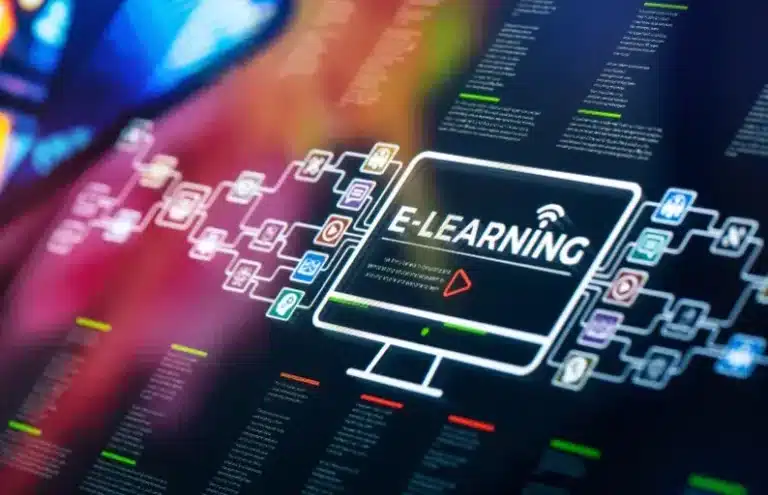In today’s business world, where everything is changing rapidly and technological advances are increasing, workers need to keep up to date and be trained to stay competitive.
Lifelong learning is already part of the daily routine of every company’s employees. However, each person has their own learning style, strengths and areas for improvement, which means that traditional training does not always reach everyone equally. This is where the UDL (Universal Design for Learning) model comes in.
UDL is a learning model that, although it was initially developed for education, its approach can be adapted and used effectively in a business context. In this article we tell you how to apply ULD in a company and transform corporate training, as well as how an e-learning platform can facilitate its implementation, creating an employee-centred learning environment.
What is the UDL Model and how does it apply to business training?

Universal Design for Learning is a teaching model that seeks to make learning accessible and effective for all learners, taking into account that not everyone is the same or has the same abilities.
UDL strategies focus on providing multiple forms of representation, expression and motivation so that all learners, regardless of their abilities and learning styles, can get the most out of learning.
But how do we apply Universal Design for Learning to the field of corporate training?
When we talk about transferring ULD to corporate training, we are referring to the development and design of internal training programmes for employees adapted to all profiles. From people with more developed cognitive and technical skills to more visual and practical people.
The aim is that every employee can access educational content and participate in training regardless of their individual characteristics, creating an inclusive and accessible environment for all equally, regardless of their abilities and learning styles.
The three principles of the UDL

- 1. Provide multiple forms of representation: instead of offering only one content format, information is presented in different forms such as text, image or video to accommodate not only different learning styles, but also to make it easier for those with visual or hearing impairments.
- 2. Provide multiple forms of representation: instead of offering only one content format, information is presented in different forms such as text, image or video to accommodate not only different learning styles, but also to make it easier for those with visual or hearing impairments.
- 3. Provide multiple forms of engagement: each employee has different motivations and expectations, some may be more motivated by the possibility of promotion within the company, while others prefer to learn simply for the sake of acquiring new skills. The model allows to maintain this motivation and encourage active participation by adapting and adjusting the content, activities and goals to keep this interest alive. An example of this SAD principle can be the use of gamification, interactive activities or specific project assignments.
Practical universal design for learning example:
Let’s imagine the following situation: when a company wants to introduce a new internal management software and needs to teach its employees how to use it. Combining the principles of UDL with the ADDIE model, the first step would be to analyse and identify the needs and learning styles of the employees, for example with short interviews or online questionnaires.
Then, design content in different formats, such as video captures of the software or documents with step-by-step instructions, to be developed and implemented on an e-learning platform.
After the training is completed, the evaluation collects feedback from employees to identify gaps and adjust the materials according to their needs for future courses.
On the other hand, when the UDL model is combined with the SAM model, the preparation phase is faster, common challenges are identified and various learning scenarios are prototyped. For example, different department leaders can meet to address the main needs of their teams, the HR department may not have the same needs and expertise as the IT department.
After this, initial modules are developed with content such as video tutorials, tests or simulations. For a more agile evaluation, these modules can be tested with small departments of employees, allowing quick changes to be made on the fly and adjusting the content according to the feedback received to adapt it to all departments.
Why is it important to implement UDL in business training?

Although it comes from the educational field, the application of UDL in business and corporate training has great potential to improve the accessibility and effectiveness of learning processes in the business environment.
UDL can be perfectly adapted to corporate training, as the challenges it faces are similar to those that can be found in the classroom: diversity of skills, experiences, learning styles and needs.
One scenario where UDL could be applied in companies would be, for example, when an organisation wants to offer its employees training in leadership strategies.
According to the principles of the model, which aims to give all employees an equal chance to learn, the content will be presented in various formats: slides with colour-blind graphics, diagrams and diagrams explaining leadership styles, videos of leaders talking about their experiences with subtitles or a PDF summary with practical examples and definitions.
To demonstrate their understanding of leadership concepts and practice what they have learned, employees can write a leadership plan for a project, make a presentation to colleagues or take a quiz to test their knowledge.
To motivate staff to actively participate in this training, they can be allowed to select from different leadership case studies according to their interests (sales, corporate social responsibility, etc.), offered positive recognition and feedback, and invited to share their experiences with other team members.
Advantages of applying the UDL model in corporate training

The UDL differs from other less flexible and traditional approaches in that it focuses on removing barriers to learning and tries to adapt to all profiles.
With a more rigid framework, where for example only content in the form of a PDF article and assessment in the form of a test without practical exercises is offered, employees’ learning opportunities are limited.
This can exclude people with specific needs, those who have difficulties using digital tools or who learn best through practical methods.
The advantages and benefits of opting for Universal Design for Learning are:
- Accessibility: Following UDL principles when creating training content ensures that it is accessible learning to employees with different visual, hearing or cognitive abilities. For example, using high colour contrast in presentations.
- Personalisation: allows employees to choose how they want to learn depending on their preferences and how they retain information. Videos, readings or activities are some of the formats for them to choose the one that best suits their learning style.
- Participation and engagement: to maintain motivation and encourage employee engagement, offer dynamics or projects designed to make them connect more with the training and its content. For example, giving employees the possibility to participate in projects and cases on topics of interest to them.
- Equity and diversity: offering multiple forms of representation and expression adapted to multicultural teams and different personal contexts removes any barriers so that everyone has equal opportunities to acquire knowledge. This can be achieved through the use of subtitles or multilingual texts.
- Business productivity: well-planned training adapted to all profiles results in more effective learning, resulting in a better prepared and motivated team. For example, learning to use new software that makes work more efficient.
- Retains talent: by offering quality training that takes into account all profiles, employees will have their learning needs met and feel valued by the organisation.
How an e-learning platform facilitates the implementation of the UDL model in companies

E-learning platforms have revolutionised the way companies deliver training to their employees, from the way content is presented to the evaluation and analysis of its effectiveness.
Thanks to their flexibility and customisability, these platforms make it very easy to develop an e-learning instructional design based on UDL principles.
Some of the ways in which an e-learning platform facilitates the application of the UDL or Universal Design for Learning model in companies are:
- Diversity of formats: one of the principles of the UDL model focuses on the representation of content. Within an e-learning platform you can offer different formats such as presentations, texts, videos, infographics and even augmented reality.
- Personalisation of learning: thanks to the continuous monitoring that e-learning platforms allow, content and activities can be adapted according to the progress and skills of each employee.
- Accessibility: e-learning platforms have functionalities that allow the content and interface to be adapted to make it more accessible. From adjusting the contrast to the size of the letters or the incorporation of subtitles.
- Flexibility: With an e-learning platform, employees can access materials from anywhere at any time, ideal for large teams located in different parts of the world.
- Data analysis: e-learning platforms allow you to collect and analyse data on employee performance and identify areas for improvement in order to adjust content and teaching strategy.
Using an e-learning platform to implement the DUA model in corporate training opens up a wide range of possibilities and makes the task of adapting and creating efficient online courses much easier.
Such tools not only facilitate the creation of more inclusive learning environments within the company, but also help to improve the employees’ experience when it comes to new job training.
